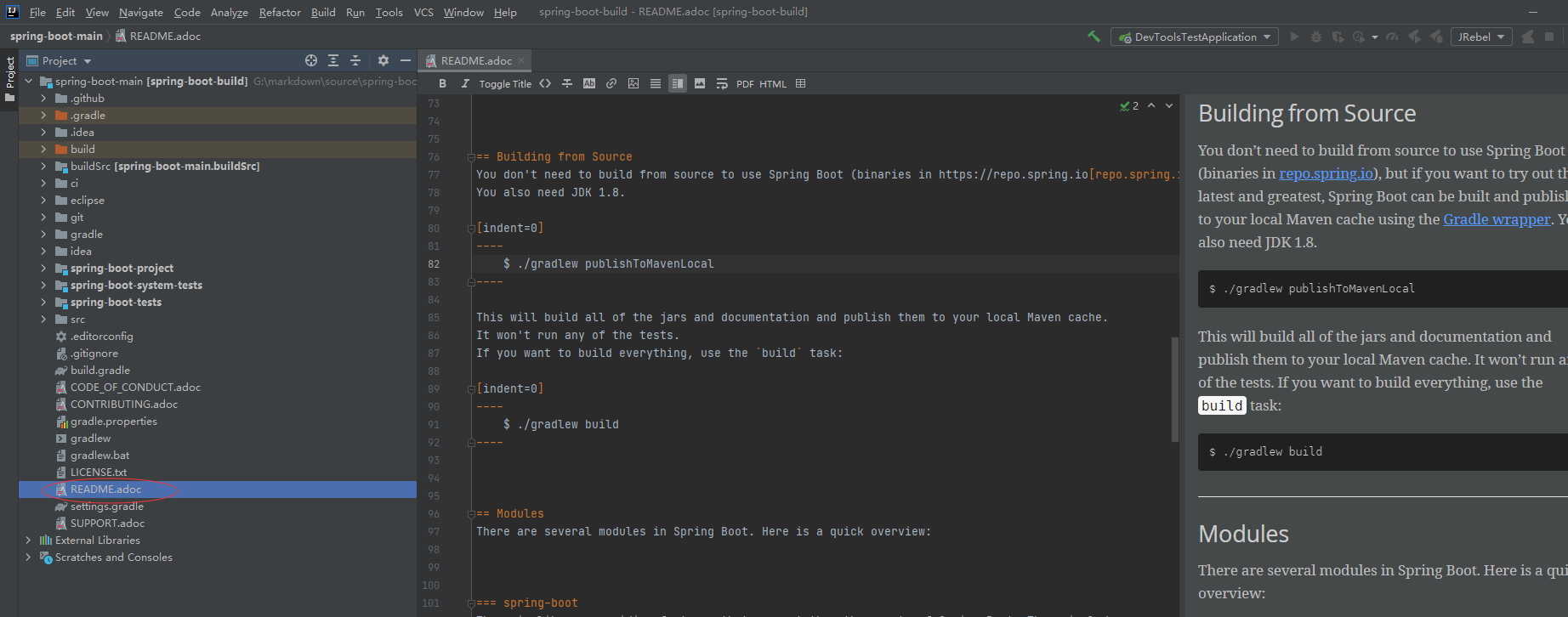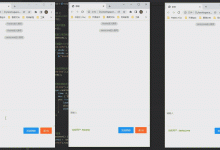Spring Boot浅聊入门
**本人博客网站 **IT小神 www.itxiaoshen.com
Spring Boot官网地址:https://spring.io/projects/spring-boot/
Spring Boot可以轻松创建独立的、基于Spring的产品级应用程序“直接运行”。
作为笔者见解,Spring Boot 不算是一个全新的框架,Spring Boot 底层还是大量依赖于Spring Framework,而Spring Framework很早以前版本就已提供基于注解、Java Config而不仅是XML配置编程;Spring Boot采用约定大于配置方式替代xml配置,是Spring Framework一个大升级版本,整合很多自动装配组件,让开发者开箱即用,接下来我们一起来聊聊Spring Boot三个重要的特性和starter开发简易剖析
Spring Boot源码编译
使用最新Releases版本v2.5.3

目前Spring boot和Spring Framework项目都是使用Gradle自动化构建工具,编译直接查看项目根目录下README.adoc文件即可,有时网络不好可以多次编译重试

零配置
Spring Web MVC简述
Spring Web Mvc官网地址 https://docs.spring.io/spring-framework/docs/current/reference/html/web.html
Spring Web MVC是基于Servlet API的原始Web框架,从一开始就包含在Spring框架中。“Spring Web MVC”的正式名称来自其源模块的名称(Spring -webmvc),但它通常被称为“Spring MVC”
零配置实现
Spring Web MVC官网开篇最前面第一章第一小节也即是1.1 DispatcherServlet中就重点引用一下这六句代码实现原来我们Spring MVC 工程web.xml里面配置功能,仅通过下面这一小段代码就初始化了Spring根容器和Web子容器,这种方式也是官方推荐使用的
public class MyWebApplicationInitializer implements WebApplicationInitializer {@Overridepublic void onStartup(ServletContext servletContext) {// Load Spring web application configurationAnnotationConfigWebApplicationContext context = new AnnotationConfigWebApplicationContext();context.register(AppConfig.class);// Create and register the DispatcherServletDispatcherServlet servlet = new DispatcherServlet(context);ServletRegistration.Dynamic registration = servletContext.addServlet("app", servlet);registration.setLoadOnStartup(1);registration.addMapping("/app/*");}}
而我们非常熟悉的Spring Web Mvc工程web.xml配置示例注册和初始化DispatcherServlet:
<web-app><listener><listener-class>org.springframework.web.context.ContextLoaderListener</listener-class></listener><context-param><param-name>contextConfigLocation</param-name><param-value>/WEB-INF/app-context.xml</param-value></context-param><servlet><servlet-name>app</servlet-name><servlet-class>org.springframework.web.servlet.DispatcherServlet</servlet-class><init-param><param-name>contextConfigLocation</param-name><param-value></param-value></init-param><load-on-startup>1</load-on-startup></servlet><servlet-mapping><servlet-name>app</servlet-name><url-pattern>/app/*</url-pattern></servlet-mapping></web-app>
父子容器
个人猜测Spring Boot基于内嵌容器特性会渐渐淡化父子容器的概念,最终只是一个大容器

内嵌容器
概述
Spring Boot 内嵌像Tomcat、Jetty、Undertow等实现Servlet规范的容器,如果有研究过Tomcat这只三脚猫logo中间件(后续有时间我们再分享一下Tomcat源码和原理)也知道Tomcat也是一个用Java语言编写的强大中间件,在Spring Boot通过New Tomcat方式来配置和启动web容器。
Spring Framework源码编译
使用最新Release版本v5.2.16.RELEASE

同样找到项目根目录下README.md,从githubSpring Framework源码 wiki找到编译源码说明


实现
根据Servlet从3.0版本之后的规范,所有实现Servlet规范的Web容器都会扫描jar包下面META-INF/services下的文件,在Spring Web子项目中利用Java 的SPI机制(SPI是一种扩展机制,很多框架底层都使用或甚至重新实现自己的SPI机制,比如像Spring和Dubbo都实现自己的SPI,以后我们再找时间来讨论,暂且到这里),在根目录下META-INF/services创建一个文件名javax.servlet.ServletContainerInitializer,文件内容是实现类的org.springframework.web.SpringServletContainerInitializer全类名

SpringServletContainerInitializer实现类针对通过@HandlesTypes感兴趣注解, 将所有实现WebApplicationInitializer的实现类放到一个Set集合中,然后再逐个调用其onStartup()方法,所以这里我们接上了1.1章节官网MyWebApplicationInitializer实现WebApplicationInitializer接口这一部分
@HandlesTypes(WebApplicationInitializer.class)public class SpringServletContainerInitializer implements ServletContainerInitializer {@Overridepublic void onStartup(@Nullable Set<Class<?>> webAppInitializerClasses, ServletContext servletContext)throws ServletException {List<WebApplicationInitializer> initializers = Collections.emptyList();if (webAppInitializerClasses != null) {initializers = new ArrayList<>(webAppInitializerClasses.size());for (Class<?> waiClass : webAppInitializerClasses) {// Be defensive: Some servlet containers provide us with invalid classes,// no matter what @HandlesTypes says...if (!waiClass.isInterface() && !Modifier.isAbstract(waiClass.getModifiers()) &&WebApplicationInitializer.class.isAssignableFrom(waiClass)) {try {initializers.add((WebApplicationInitializer)ReflectionUtils.accessibleConstructor(waiClass).newInstance());}catch (Throwable ex) {throw new ServletException("Failed to instantiate WebApplicationInitializer class", ex);}}}}if (initializers.isEmpty()) {servletContext.log("No Spring WebApplicationInitializer types detected on classpath");return;}servletContext.log(initializers.size() + " Spring WebApplicationInitializers detected on classpath");AnnotationAwareOrderComparator.sort(initializers);for (WebApplicationInitializer initializer : initializers) {initializer.onStartup(servletContext);}}}
接下来我们再来看看Web容器如Tomcat是如何在Spring Boot中运行的,首先我们先得知道SpringBoot启动过程,我们知道Spring Boot 应用程序都是从SpringApplication.run开始的,而run方法则始于SpringApplication类,返回ApplicationContext接口的子接口ConfigurableApplicationContext,通过refreshContext方法调用Spring Framework最大名鼎鼎的refresh方法初始化Spring容器,而refresh方法中的onRefresh是留给子类扩展使用的,而也是在这里开始初始化Web容器的


找到其实现类ServletWebServerApplicationContext,在这里createWebServer开始创建WebServer,


这里会根据我们我们pom文件starter依赖来决定创建Tomcat、Undertow、Jetty,Undertow在并发下性能明显优化另外Tomcat和Jetty,建议优先使用Undertow,但这里由于大家对于Tomcat印象比较深刻,所以我们示例还是以Tomcat为主
Spring Boot内嵌容器默认为Tomcat,想要换成Undertow也是非常容易的,只需修改spring-boot-starter-web依赖,移除tomcat的依赖:
<dependency><groupId>org.springframework.boot</groupId><artifactId>spring-boot-starter-web</artifactId><exclusions><exclusion><groupId>org.springframework.boot</groupId><artifactId>spring-boot-starter-tomcat</artifactId></exclusion></exclusions></dependency>
添加undertow依赖:
<dependency><groupId>org.springframework.boot</groupId><artifactId>spring-boot-starter-undertow</artifactId></dependency>
server:port: 8084http2:enabled: trueundertow:io-threads: 16worker-threads: 256buffer-size: 1024buffers-per-region: 1024direct-buffers: true
至此,这里我们通过ServletWebServerFactory的实现类TomcatServletWebServerFactory的getWebServer方法找到new Tomcat的源码


@Overridepublic WebServer getWebServer(ServletContextInitializer... initializers) {if (this.disableMBeanRegistry) {Registry.disableRegistry();}Tomcat tomcat = new Tomcat();File baseDir = (this.baseDirectory != null) ? this.baseDirectory : createTempDir("tomcat");tomcat.setBaseDir(baseDir.getAbsolutePath());Connector connector = new Connector(this.protocol);connector.setThrowOnFailure(true);tomcat.getService().addConnector(connector);customizeConnector(connector);tomcat.setConnector(connector);tomcat.getHost().setAutoDeploy(false);configureEngine(tomcat.getEngine());for (Connector additionalConnector : this.additionalTomcatConnectors) {tomcat.getService().addConnector(additionalConnector);}prepareContext(tomcat.getHost(), initializers);return getTomcatWebServer(tomcat);}
自动装配
@SpringBootApplication注解
我们知道所有运用Spring Boot应用程序在根目录的主类上都标有一个@SpringBootApplication的注解,这个就是SpringBoot自动装配实现的入口,我们接下来一步步的来分析,首先@SpringBootApplication在org.springframework.boot.autoconfigure.SpringBootApplication中,Spring Boot的自动装配也都是在org.springframework.boot.autoconfigure项目里实现的

而我们经常看到spring-boot-starter-xxx这种里面主要是定义了依赖包装成一个个启动器,实际实现还是在spring-boot-autoconfigure中,这些都是Spring Boot官方帮我们整合实现并提供开箱即可工具,此外还有一些第三方整合提供以xxx开头的xxx-spring-boot-starter比如阿里巴巴的druid-spring-boot-starter和苞米豆mybatis-plus-boot-starter等

在@SpringBootApplication注解里主要有下面这三个注解
-
@SpringBootConfiguration(继承了Configuration,表示当前是注解类)
-
@ComponentScan (包含扫描和排除扫描组件配置)
-
@EnableAutoConfiguration (在这里开启Spring Boot的自动配置注解功能)
@AutoConfigurationPackage
- @Import(AutoConfigurationImportSelector.class)
核心之核心的地方就是借助@import导入AutoConfigurationImportSelector,这个是Spring中ImportSelector接口的实现类,ImportSelect接口是org.springframework.context里的内容,在Spring Framework 3.1版本之后就有,后续我们有时间讨论Spring Framework 的时候再来详说



重要的方法也即是这个getCandidateConfigurations,调用loadFactoryNames,而loadFactoryNames调用loadSpringFactories方法,classLoader.getResources这里就是谜底揭开的时候,通过JDK classLoader加载FACTORIES_RESOURCE_LOCATION(META-INF/spring.factories)文件内容
protected List<String> getCandidateConfigurations(AnnotationMetadata metadata, AnnotationAttributes attributes) {List<String> configurations = SpringFactoriesLoader.loadFactoryNames(getSpringFactoriesLoaderFactoryClass(),getBeanClassLoader());Assert.notEmpty(configurations, "No auto configuration classes found in META-INF/spring.factories. If you "+ "are using a custom packaging, make sure that file is correct.");return configurations;}public static List<String> loadFactoryNames(Class<?> factoryType, @Nullable ClassLoader classLoader) {ClassLoader classLoaderToUse = classLoader;if (classLoaderToUse == null) {classLoaderToUse = SpringFactoriesLoader.class.getClassLoader();}String factoryTypeName = factoryType.getName();return loadSpringFactories(classLoaderToUse).getOrDefault(factoryTypeName, Collections.emptyList());}private static Map<String, List<String>> loadSpringFactories(ClassLoader classLoader) {Map<String, List<String>> result = cache.get(classLoader);if (result != null) {return result;}result = new HashMap<>();try {Enumeration<URL> urls = classLoader.getResources(FACTORIES_RESOURCE_LOCATION);while (urls.hasMoreElements()) {URL url = urls.nextElement();UrlResource resource = new UrlResource(url);Properties properties = PropertiesLoaderUtils.loadProperties(resource);for (Map.Entry<?, ?> entry : properties.entrySet()) {String factoryTypeName = ((String) entry.getKey()).trim();String[] factoryImplementationNames =StringUtils.commaDelimitedListToStringArray((String) entry.getValue());for (String factoryImplementationName : factoryImplementationNames) {result.computeIfAbsent(factoryTypeName, key -> new ArrayList<>()).add(factoryImplementationName.trim());}}}// Replace all lists with unmodifiable lists containing unique elementsresult.replaceAll((factoryType, implementations) -> implementations.stream().distinct().collect(Collectors.collectingAndThen(Collectors.toList(), Collections::unmodifiableList)));cache.put(classLoader, result);}catch (IOException ex) {throw new IllegalArgumentException("Unable to load factories from location [" +FACTORIES_RESOURCE_LOCATION + "]", ex);}return result;}

通过spring-boot-autoconfigure的resource目录下META-INF目录找到spring.factories文件后我们可以看到这里面就是Spring SPI机制实现,在此定义一个规范的路径和文件名,文件内容放置了一个个Spring Boot提供自动装配的组件,而后面我们可想而知Spring Boot底层肯定还是利用反射机制将这些类放到Spring容器中管理,我们就可以通过Spring Boot通用三板斧使用步骤,第一步加坐标依赖starter,第二步启动类中开启使用注解,第三步配置配置文件参数后轻松使用工具类的功能

Starter开发简易剖析
步骤
- 建立autoconfigure工程开发自动配置的实现类xxxProperties.class 提供参数配置实现类,比如redis的host、url等,我们也可以从这里找到所有配置参数信息
- xxxConnectionConfiguration.class,由@Import注解导入依赖类
- xxxAutoConfiguration实现类,然后通过Java Config和@Bean注解方式将Java Bean注册到Spring容器里,后续使用则直接从Spring容器中拿即可
RedisAutoConfiguration分析
RedisAutoConfiguration实现
@Configuration(proxyBeanMethods = false)@ConditionalOnClass(RedisOperations.class)@EnableConfigurationProperties(RedisProperties.class)@Import({ LettuceConnectionConfiguration.class, JedisConnectionConfiguration.class })public class RedisAutoConfiguration {@Bean@ConditionalOnMissingBean(name = "redisTemplate")@ConditionalOnSingleCandidate(RedisConnectionFactory.class)public RedisTemplate<Object, Object> redisTemplate(RedisConnectionFactory redisConnectionFactory) {RedisTemplate<Object, Object> template = new RedisTemplate<>();template.setConnectionFactory(redisConnectionFactory);return template;}@Bean@ConditionalOnMissingBean@ConditionalOnSingleCandidate(RedisConnectionFactory.class)public StringRedisTemplate stringRedisTemplate(RedisConnectionFactory redisConnectionFactory) {StringRedisTemplate template = new StringRedisTemplate();template.setConnectionFactory(redisConnectionFactory);return template;}}
Redis Starter依赖
plugins {id "org.springframework.boot.starter"}description = "Starter for using Redis key-value data store with Spring Data Redis and the Lettuce client"dependencies {api(project(":spring-boot-project:spring-boot-starters:spring-boot-starter"))api("org.springframework.data:spring-data-redis")api("io.lettuce:lettuce-core")}
 爱站程序员基地
爱站程序员基地


